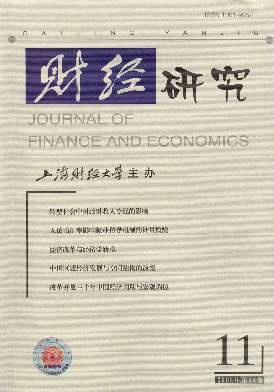30年工业比较优势的动态演进
财经研究 2008 年 第 34 卷第 11 期, 页码:64 - 76
摘要
参考文献
摘要
文章通过对中国出口结构变迁的数据分析后得到三个发现:一是作为全球劳动力最丰富的国家,中国劳动密集型产品占出口比重快速下降。二是出口结构不断转向包含更多人力资本的技术类产品,表明劳动力要素禀赋的内涵发生了重大变化。三是制造业中的资本密集型工业的出口竞争力还很弱,预示着提升资本密集型产业的竞争力是未来出口结构的调整方向。
[1]G M格罗斯曼,E赫尔普曼.全球经济中的创新与增长[M].北京:中国人民大学出版社,2003.
[2]迈克尔-托达罗.经济发展[M].北京:中国经济出版社,1999.
[3]保尔-克鲁格曼.克鲁格曼国际贸易新理论[M].北京:中国社会科学出版社,2001.
[4]世界经济协会.1983/1984年世界经济年鉴.
[5]殷醒民.技术扩散效应论[M].上海:复旦大学出版社,2006.
[6]Acemoglu D.F Zilibotti.Productivity difference[J].Quarterly Journal of Economics,2001,116(2):563-606.
[7]Alwyn Young.Leaning by doing and the dynamic effects of international trade[J].Quar-terly Journal of Economics,1991,106:369-405.
[8]Chuang Yih-Chyi.Learning by doing,the technology gap,and growth[J].InternationalEconomic Review,1998,39(3):697-721.
[9]Clerides S,S Lach,J Tybout.Is learning-by-exporting important?Micro-dynamic evi-dence from Columbia,Mexico,and Morocco[J].Quarterly Journal of Economics,1998,113:903-947.
[10]Feder Gershon.On exports and economic growth[J].Journal of Development Econom-ics,1983,12(1-2):59-73.
[11]Horst Siebert.China:Coming to grips with the new global player[R].The World E-conomy,2007.
[12]Matsuyama K.Agricultural productivity,comparative advantage,and economic growth[J].Journal of Economic Theory,1992,58(2):317-334.
[13]Robert Chang,Linda Kaltani,Norman Loayza.Openness can be good for growth———The role of policy complementarities[R].World Bank,Policy Research Working Paper3763,2005.
[14]Sachs J D,A Warner.Economic reform and the process of global integration[R].Brookings Papers on Economic Activity,1995:1-118.
[15]Stefan Lachenmaier,Ludger W ssmann.Does innovation cause exports?Evidence fromexogennous innovation impulses and obstacles using German microdata[J].Oxford Eco-nomic Papers,2006,58:317-350.
[16]Westphal L.Technology strategies for economic development in a fast changing globaleconomy[J].Economics of Innovation and New Technology,2002,11(4-5):275-320.
[17]Yin Xing-min,Xu Ke-zhen.Effects of technology diffusion on trade performance:Acase of Yangtze Delta[J].Fudan Journal of the Humanities and Social Sciences,2004,1(1):200-217.
①根据世界银行的指标,2005年的中等收入国家的人均收入是2 647美元,以购买力平价计算是7 199美元;而上中等收入国家的人均收入是5 634美元,以购买力平价计算则是10 931美元。世界银行:2007 World Development Indicators,Washington DC.2007.
②引自保尔-克鲁格曼:《克鲁格曼国际贸易新理论》,北京:中国社会科学出版社2001年版,第105页。
③可参见Feder,Gershon:“On Exports and Economic Growth”,Journal of Development E-conomics,12(1983),No.1-2:59-73.
④可参见Alwyn Young:“Leaning by Doing and the Dynamic Effects of InternationalTrade”,Quarterly Journal of Economics 106(1991):369-405.
⑤可参见Acemoglu,D.and F.Zilibotti:“Productivity Difference”,Quarterly Journal ofEconomics 116(2,2001):563-606.
⑥可参见Robert Chang,Linda Kaltani,Norman Loayza:“Openness Can be Good forGrowth—The Role of Policy Complementarities”,World Bank,Policy Research Work-ing Paper 3763(November 2005):27.
⑦可参见Horst Siebert:“China:Coming to Grips with the New Global Player”,The WorldEconomy,p.896.
⑧参见殷醒民:《技术扩散效应论》第四章“对外贸易与技术扩散相关性的实证分析”,复旦大学出版社2006年版。
⑨可参见Chuang,Yih-Chyi:“Learning by Doing,the Technology Gap,and Growth”,In-ternational Economic Review,39(1998),No.3:697-721.
⑩可参见Westphal,L.:“Technology Strategies for Economic Development in a Fast ChangingGlobal Economy”,Economics of Innovation and New Technology,11(4-5,2002):275-320.
11可参见Clerides,S.,S.Lach,and J.Tybout:“Is Learning-by-Exporting Important?Mi-cro-Dynamic Evidence from Columbia,Mexico,and Morocco”,Quarterly Journal of Eco-nomics,113(3,1998):903-947.
12可参见Stefan Lachenmaier and Ludger W ssmann:“Does innovation cause exports?Evi-dence from exogenenous innovation impulses and obstacles using German microdata”,Ox-ford Economic Papers 58(2006):317-350.
13可参见G.M.格罗斯曼和E.赫尔普曼:《全球经济中的创新与增长》,北京:中国人民大学出版社2003年版,第306页。
[2]迈克尔-托达罗.经济发展[M].北京:中国经济出版社,1999.
[3]保尔-克鲁格曼.克鲁格曼国际贸易新理论[M].北京:中国社会科学出版社,2001.
[4]世界经济协会.1983/1984年世界经济年鉴.
[5]殷醒民.技术扩散效应论[M].上海:复旦大学出版社,2006.
[6]Acemoglu D.F Zilibotti.Productivity difference[J].Quarterly Journal of Economics,2001,116(2):563-606.
[7]Alwyn Young.Leaning by doing and the dynamic effects of international trade[J].Quar-terly Journal of Economics,1991,106:369-405.
[8]Chuang Yih-Chyi.Learning by doing,the technology gap,and growth[J].InternationalEconomic Review,1998,39(3):697-721.
[9]Clerides S,S Lach,J Tybout.Is learning-by-exporting important?Micro-dynamic evi-dence from Columbia,Mexico,and Morocco[J].Quarterly Journal of Economics,1998,113:903-947.
[10]Feder Gershon.On exports and economic growth[J].Journal of Development Econom-ics,1983,12(1-2):59-73.
[11]Horst Siebert.China:Coming to grips with the new global player[R].The World E-conomy,2007.
[12]Matsuyama K.Agricultural productivity,comparative advantage,and economic growth[J].Journal of Economic Theory,1992,58(2):317-334.
[13]Robert Chang,Linda Kaltani,Norman Loayza.Openness can be good for growth———The role of policy complementarities[R].World Bank,Policy Research Working Paper3763,2005.
[14]Sachs J D,A Warner.Economic reform and the process of global integration[R].Brookings Papers on Economic Activity,1995:1-118.
[15]Stefan Lachenmaier,Ludger W ssmann.Does innovation cause exports?Evidence fromexogennous innovation impulses and obstacles using German microdata[J].Oxford Eco-nomic Papers,2006,58:317-350.
[16]Westphal L.Technology strategies for economic development in a fast changing globaleconomy[J].Economics of Innovation and New Technology,2002,11(4-5):275-320.
[17]Yin Xing-min,Xu Ke-zhen.Effects of technology diffusion on trade performance:Acase of Yangtze Delta[J].Fudan Journal of the Humanities and Social Sciences,2004,1(1):200-217.
①根据世界银行的指标,2005年的中等收入国家的人均收入是2 647美元,以购买力平价计算是7 199美元;而上中等收入国家的人均收入是5 634美元,以购买力平价计算则是10 931美元。世界银行:2007 World Development Indicators,Washington DC.2007.
②引自保尔-克鲁格曼:《克鲁格曼国际贸易新理论》,北京:中国社会科学出版社2001年版,第105页。
③可参见Feder,Gershon:“On Exports and Economic Growth”,Journal of Development E-conomics,12(1983),No.1-2:59-73.
④可参见Alwyn Young:“Leaning by Doing and the Dynamic Effects of InternationalTrade”,Quarterly Journal of Economics 106(1991):369-405.
⑤可参见Acemoglu,D.and F.Zilibotti:“Productivity Difference”,Quarterly Journal ofEconomics 116(2,2001):563-606.
⑥可参见Robert Chang,Linda Kaltani,Norman Loayza:“Openness Can be Good forGrowth—The Role of Policy Complementarities”,World Bank,Policy Research Work-ing Paper 3763(November 2005):27.
⑦可参见Horst Siebert:“China:Coming to Grips with the New Global Player”,The WorldEconomy,p.896.
⑧参见殷醒民:《技术扩散效应论》第四章“对外贸易与技术扩散相关性的实证分析”,复旦大学出版社2006年版。
⑨可参见Chuang,Yih-Chyi:“Learning by Doing,the Technology Gap,and Growth”,In-ternational Economic Review,39(1998),No.3:697-721.
⑩可参见Westphal,L.:“Technology Strategies for Economic Development in a Fast ChangingGlobal Economy”,Economics of Innovation and New Technology,11(4-5,2002):275-320.
11可参见Clerides,S.,S.Lach,and J.Tybout:“Is Learning-by-Exporting Important?Mi-cro-Dynamic Evidence from Columbia,Mexico,and Morocco”,Quarterly Journal of Eco-nomics,113(3,1998):903-947.
12可参见Stefan Lachenmaier and Ludger W ssmann:“Does innovation cause exports?Evi-dence from exogenenous innovation impulses and obstacles using German microdata”,Ox-ford Economic Papers 58(2006):317-350.
13可参见G.M.格罗斯曼和E.赫尔普曼:《全球经济中的创新与增长》,北京:中国人民大学出版社2003年版,第306页。
引用本文
殷醒民. 30年工业比较优势的动态演进[J]. 财经研究, 2008, 34(11): 64–76.
导出参考文献,格式为:





 6371
6371  3796
3796

